8 Linear Programming and Mixed-Integer Linear Programming
Travelling Salesman Problem
This example shows how to use binary integer programming to solve the classic
travelling salesman problem. This problem involves finding the shortest closed tour
(path) through a set of stops (cities). In this case there are 200 stops, but you can easily
change the nStops variable to get a different problem size. You'll solve the initial
problem and see that the solution has subtours. This means the optimal solution
found doesn't give one continuous path through all the points, but instead has several
disconnected loops. You'll then use an iterative process of determining the subtours,
adding constraints, and rerunning the optimization until the subtours are eliminated.
Draw the Map and Stops
Generate random stops inside a crude polygonal representation of the continental U.S.
figure;
load('usborder.mat','x','y','xx','yy');
rng(3,'twister') % makes a plot with stops in Maine & Florida, and is reproducible
nStops = 200; % you can use any number, but the problem size scales as N^2
stopsLon = zeros(nStops,1); % allocate x-coordinates of nStops
stopsLat = stopsLon; % allocate y-coordinates
n = 1;
while (n <= nStops)
xp = rand*1.5;
yp = rand;
if inpolygon(xp,yp,xx,yy) % test if inside the border
stopsLon(n) = xp;
stopsLat(n) = yp;
n = n+1;
end
end
plot(x,y,'Color','red'); % draw the outside border
hold on
% Add the stops to the map
plot(stopsLon,stopsLat,'*b')
hold off
8-44
�
Travelling Salesman Problem
Problem Formulation
Formulate the travelling salesman problem for integer linear programming as follows:
• Generate all possible trips, meaning all distinct pairs of stops.
• Calculate the distance for each trip.
• The cost function to minimize is the sum of the trip distances for each trip in the tour.
• The decision variables are binary, and associated with each trip, where each 1
represents a trip that exists on the tour, and each 0 represents a trip that is not on
the tour.
8-45
�
8 Linear Programming and Mixed-Integer Linear Programming
• To ensure that the tour includes every stop, include the linear constraint that each
stop is on exactly two trips. This means one arrival and one departure from the stop.
Calculate Distances Between Points
Because there are 200 stops, there are 19,900 trips, meaning 19,900 binary variables (∥
variables = 200 choose 2).
Generate all the trips, meaning all pairs of stops.
idxs = nchoosek(1:nStops,2);
Calculate all the trip distances, assuming that the earth is flat in order to use the
Pythagorean rule.
dist = hypot(stopsLat(idxs(:,1)) - stopsLat(idxs(:,2)), ...
stopsLon(idxs(:,1)) - stopsLon(idxs(:,2)));
lendist = length(dist);
With this definition of the dist vector, the length of a tour is
dist'*x
where x is the binary solution vector. This is the distance of a tour that you try to
minimize.
Equality Constraints
The problem has two types of equality constraints. The first enforces that there must
be 200 trips total. The second enforces that each stop must have two trips attached to it
(there must be a trip to each stop and a trip departing each stop).
Specify the first type of equality constraint, that you must have nStops trips, in the form
Aeq*x = beq.
Aeq = spones(1:length(idxs)); % Adds up the number of trips
beq = nStops;
To specify the second type of equality constraint, that there needs to be two trips
attached to each stop, extend the Aeq matrix as sparse.
Aeq = [Aeq;spalloc(nStops,length(idxs),nStops*(nStops-1))]; % allocate a sparse matrix
8-46
�
Travelling Salesman Problem
for ii = 1:nStops
whichIdxs = (idxs == ii); % find the trips that include stop ii
whichIdxs = sparse(sum(whichIdxs,2)); % include trips where ii is at either end
Aeq(ii+1,:) = whichIdxs'; % include in the constraint matrix
end
beq = [beq; 2*ones(nStops,1)];
Binary Bounds
All decision variables are binary. Now, set the intcon argument to the number of
decision variables, put a lower bound of 0 on each, and an upper bound of 1.
intcon = 1:lendist;
lb = zeros(lendist,1);
ub = ones(lendist,1);
Optimize Using intlinprog
The problem is ready to be solved. Call the solver.
opts = optimoptions('intlinprog','Display','off');
[xopt,costopt,exitflag,output] = intlinprog(dist,intcon,[],[],Aeq,beq,lb,ub,opts);
Visualize the Solution
hold on
segments = find(xopt); % Get indices of lines on optimal path
lh = zeros(nStops,1); % Use to store handles to lines on plot
lh = updateSalesmanPlot(lh,xopt,idxs,stopsLon,stopsLat);
title('Solution with Subtours');
8-47
�
8 Linear Programming and Mixed-Integer Linear Programming
As can be seen on the map, the solution has several subtours. The constraints specified
so far do not prevent these subtours from happening. In order to prevent any possible
subtour from happening, you would need an incredibly large number of inequality
constraints.
Subtour Constraints
Because you can't add all of the subtour constraints, take an iterative approach. Detect
the subtours in the current solution, then add inequality constraints to prevent those
particular subtours from happening. By doing this, you find a suitable tour in a few
iterations.
Eliminate subtours with inequality constraints. An example of how this works is if you
have five points in a subtour, then you have five lines connecting those points to create
8-48
�
Travelling Salesman Problem
the subtour. Eliminate this subtour by implementing an inequality constraint to say
there must be less than or equal to four lines between these five points.
Even more, find all lines between these five points, and constrain the solution not to have
more than four of these lines present. This is a correct constraint because if five or more
of the lines existed in a solution, then the solution would have a subtour (a graph with
nodes and
The detectSubtours function analyzes the solution and returns a cell array of vectors.
Each vector in the cell array contains the stops involved in that particular subtour.
edges always contains a cycle).
tours = detectSubtours(xopt,idxs);
numtours = length(tours); % number of subtours
fprintf('# of subtours: %d\n',numtours);
# of subtours: 28
Include the linear inequality constraints to eliminate subtours, and repeatedly call the
solver, until just one subtour remains.
A = spalloc(0,lendist,0); % Allocate a sparse linear inequality constraint matrix
b = [];
while numtours > 1 % repeat until there is just one subtour
% Add the subtour constraints
b = [b;zeros(numtours,1)]; % allocate b
A = [A;spalloc(numtours,lendist,nStops)]; % a guess at how many nonzeros to allocate
for ii = 1:numtours
rowIdx = size(A,1)+1; % Counter for indexing
subTourIdx = tours{ii}; % Extract the current subtour
% The next lines find all of the variables associated with the
% particular subtour, then add an inequality constraint to prohibit
% that subtour and all subtours that use those stops.
variations = nchoosek(1:length(subTourIdx),2);
for jj = 1:length(variations)
whichVar = (sum(idxs==subTourIdx(variations(jj,1)),2)) & ...
(sum(idxs==subTourIdx(variations(jj,2)),2));
A(rowIdx,whichVar) = 1;
end
b(rowIdx) = length(subTourIdx)-1; % One less trip than subtour stops
end
% Try to optimize again
[xopt,costopt,exitflag,output] = intlinprog(dist,intcon,A,b,Aeq,beq,lb,ub,opts);
8-49
�
8 Linear Programming and Mixed-Integer Linear Programming
% Visualize result
lh = updateSalesmanPlot(lh,xopt,idxs,stopsLon,stopsLat);
% How many subtours this time?
tours = detectSubtours(xopt,idxs);
numtours = length(tours); % number of subtours
fprintf('# of subtours: %d\n',numtours);
end
title('Solution with Subtours Eliminated');
hold off
# of subtours: 22
# of subtours: 10
# of subtours: 5
# of subtours: 3
# of subtours: 4
# of subtours: 1
8-50
�
Travelling Salesman Problem
Solution Quality
The solution represents a feasible tour, because it is a single closed loop. But is it a
minimal-cost tour? One way to find out is to examine the output structure.
output
output =
relativegap: 0.0100
absolutegap: 0.0021
numfeaspoints: 5
numnodes: 2258
constrviolation: 2.5580e-13
8-51
�
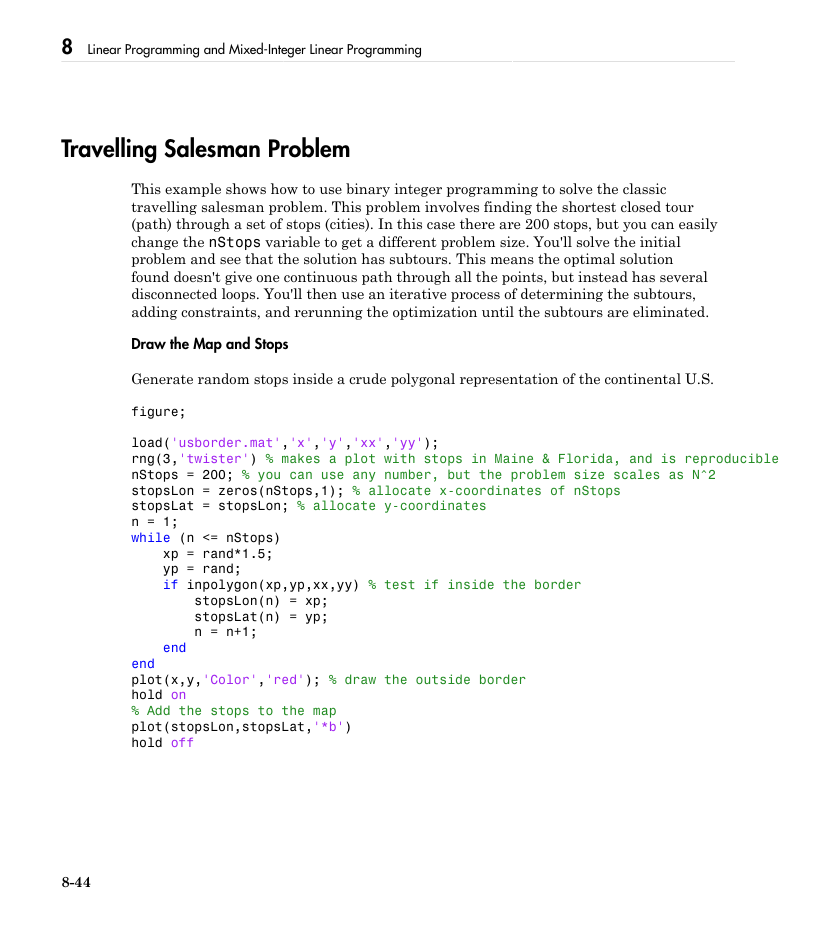
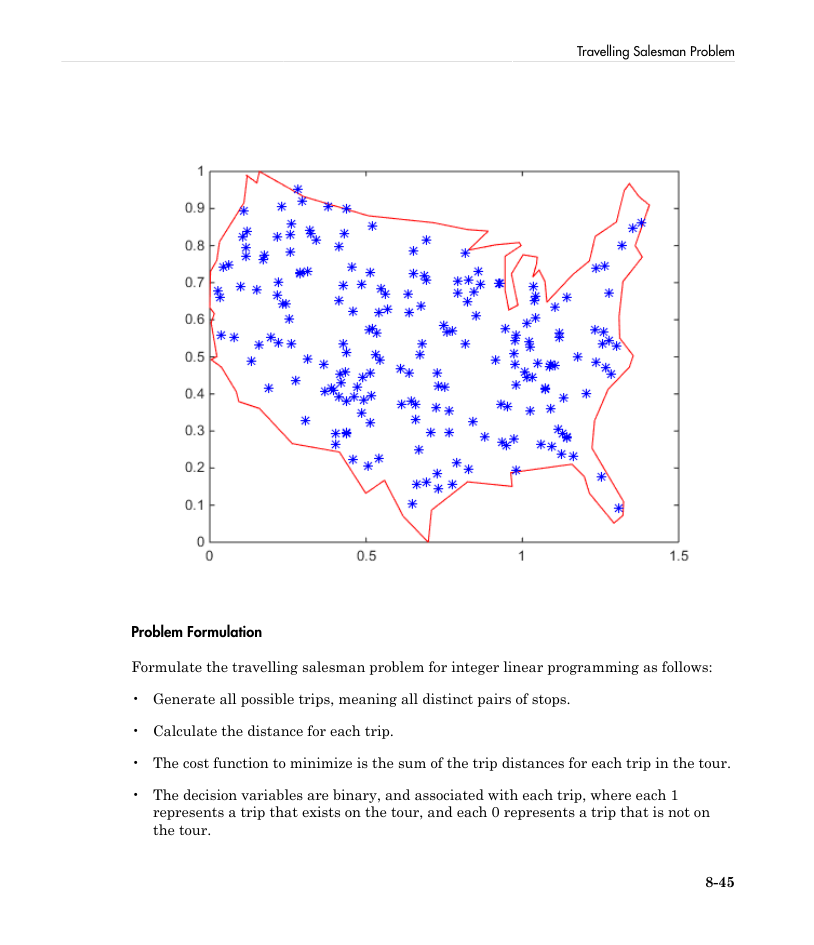
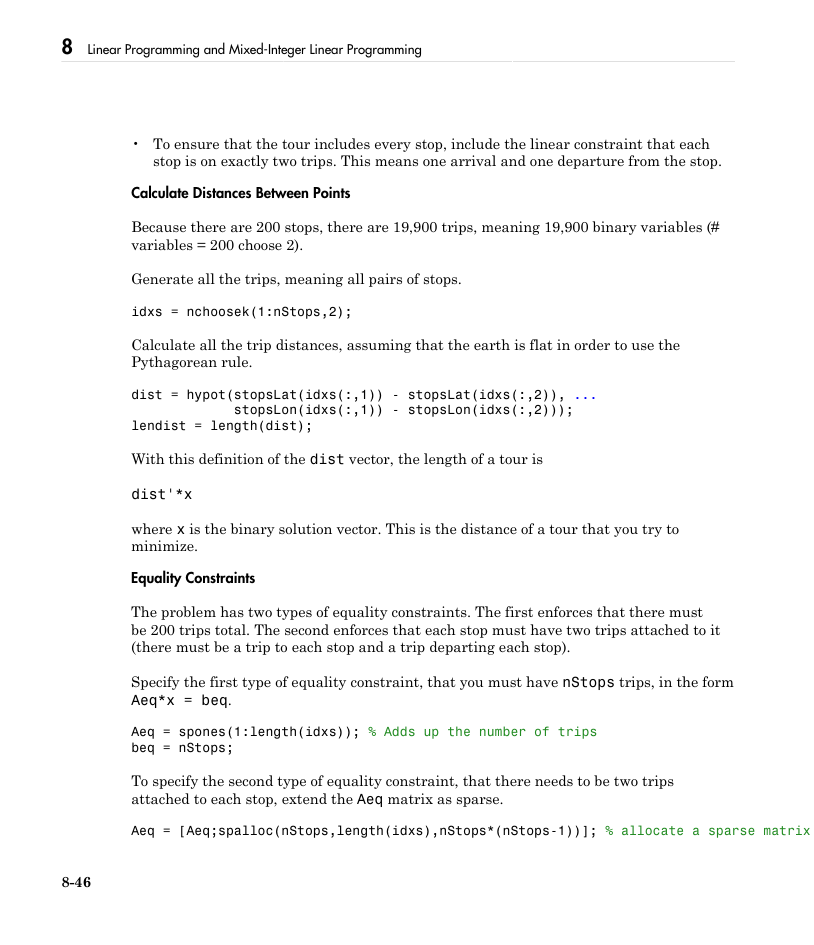
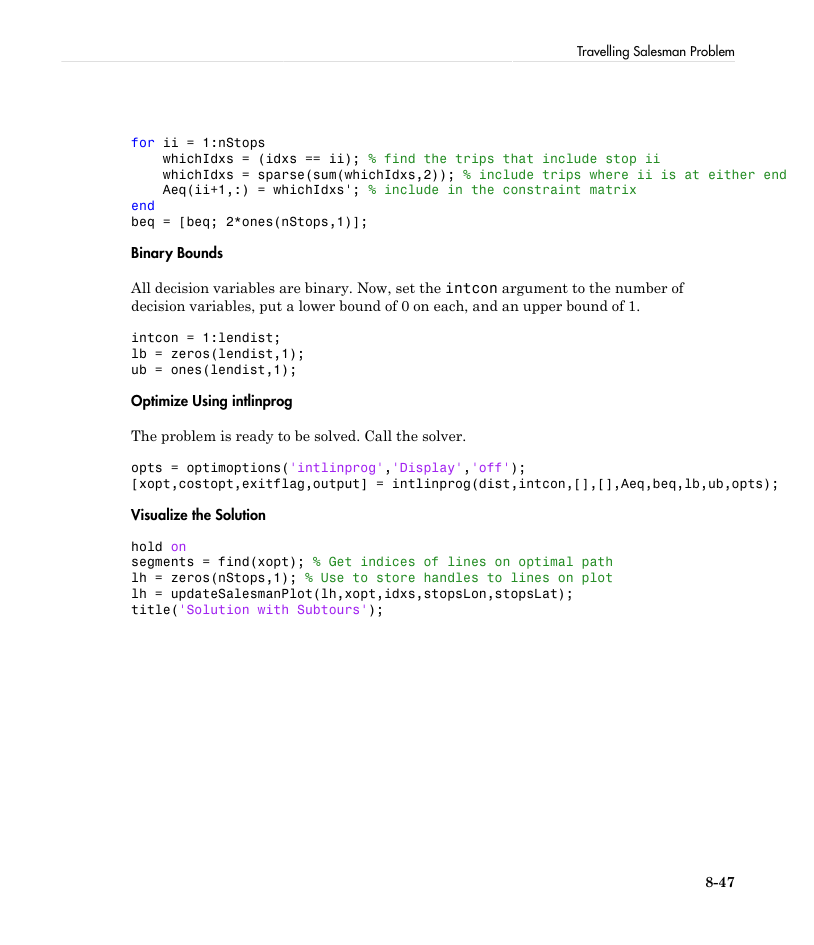
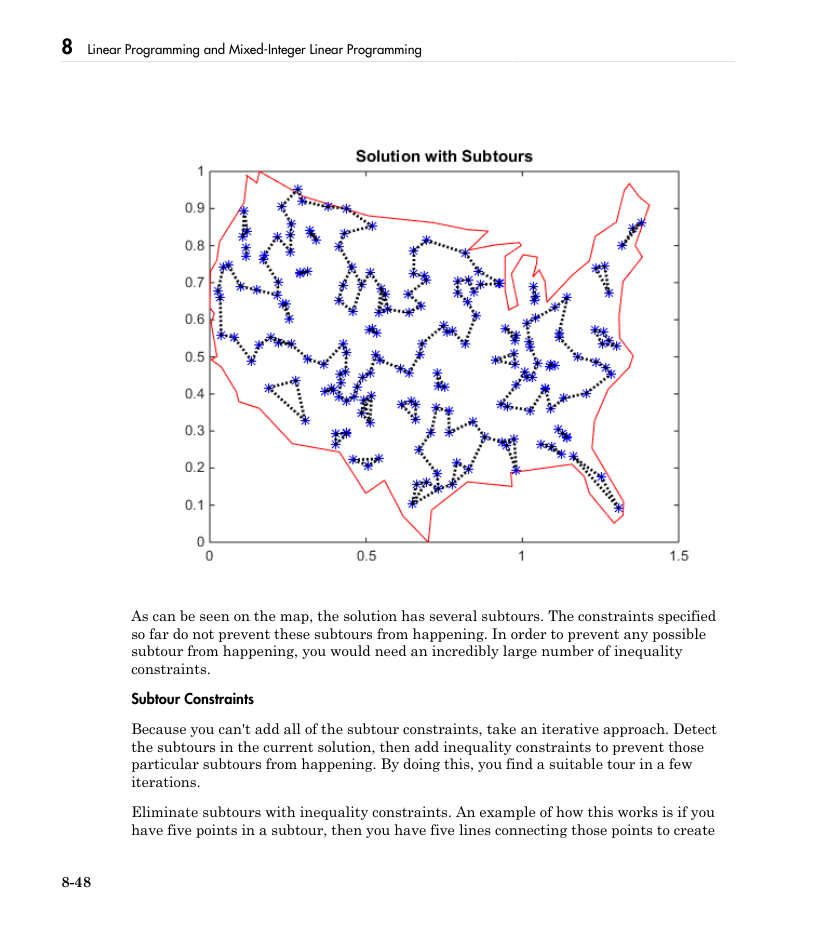
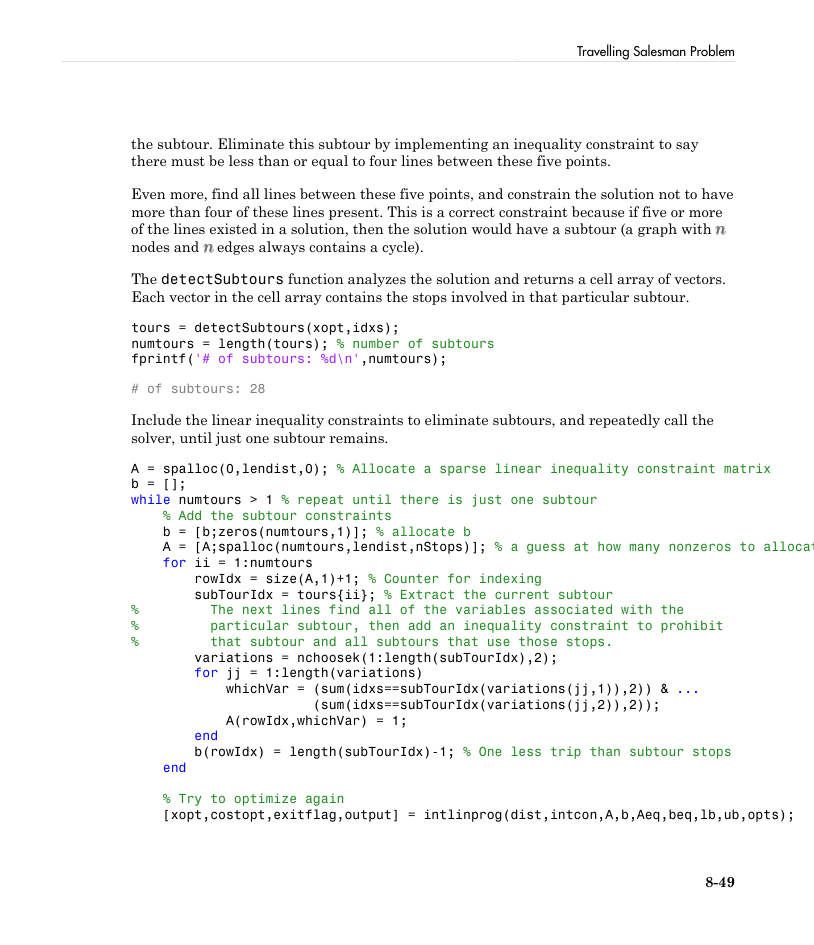
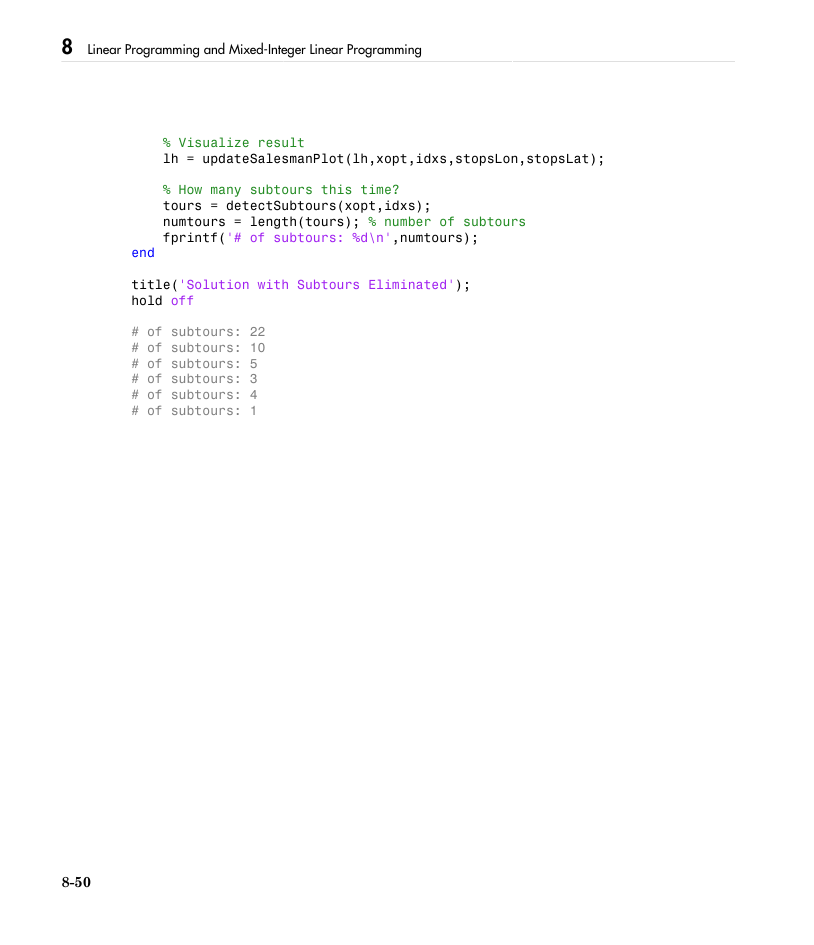
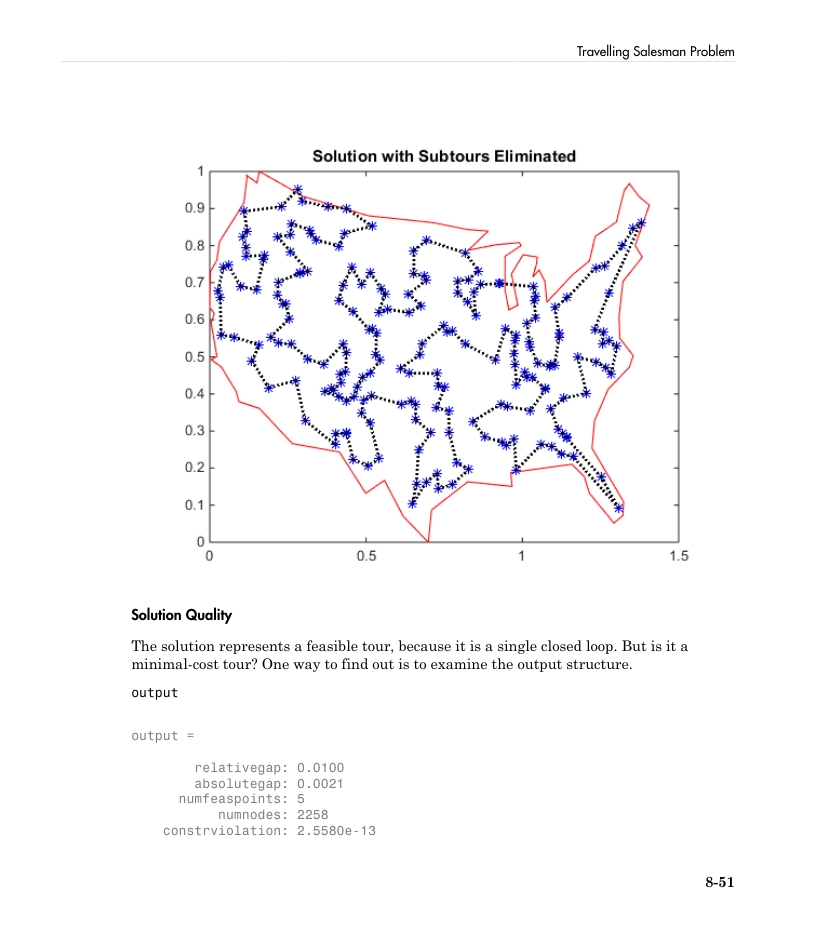








 2023年江西萍乡中考道德与法治真题及答案.doc
2023年江西萍乡中考道德与法治真题及答案.doc 2012年重庆南川中考生物真题及答案.doc
2012年重庆南川中考生物真题及答案.doc 2013年江西师范大学地理学综合及文艺理论基础考研真题.doc
2013年江西师范大学地理学综合及文艺理论基础考研真题.doc 2020年四川甘孜小升初语文真题及答案I卷.doc
2020年四川甘孜小升初语文真题及答案I卷.doc 2020年注册岩土工程师专业基础考试真题及答案.doc
2020年注册岩土工程师专业基础考试真题及答案.doc 2023-2024学年福建省厦门市九年级上学期数学月考试题及答案.doc
2023-2024学年福建省厦门市九年级上学期数学月考试题及答案.doc 2021-2022学年辽宁省沈阳市大东区九年级上学期语文期末试题及答案.doc
2021-2022学年辽宁省沈阳市大东区九年级上学期语文期末试题及答案.doc 2022-2023学年北京东城区初三第一学期物理期末试卷及答案.doc
2022-2023学年北京东城区初三第一学期物理期末试卷及答案.doc 2018上半年江西教师资格初中地理学科知识与教学能力真题及答案.doc
2018上半年江西教师资格初中地理学科知识与教学能力真题及答案.doc 2012年河北国家公务员申论考试真题及答案-省级.doc
2012年河北国家公务员申论考试真题及答案-省级.doc 2020-2021学年江苏省扬州市江都区邵樊片九年级上学期数学第一次质量检测试题及答案.doc
2020-2021学年江苏省扬州市江都区邵樊片九年级上学期数学第一次质量检测试题及答案.doc 2022下半年黑龙江教师资格证中学综合素质真题及答案.doc
2022下半年黑龙江教师资格证中学综合素质真题及答案.doc